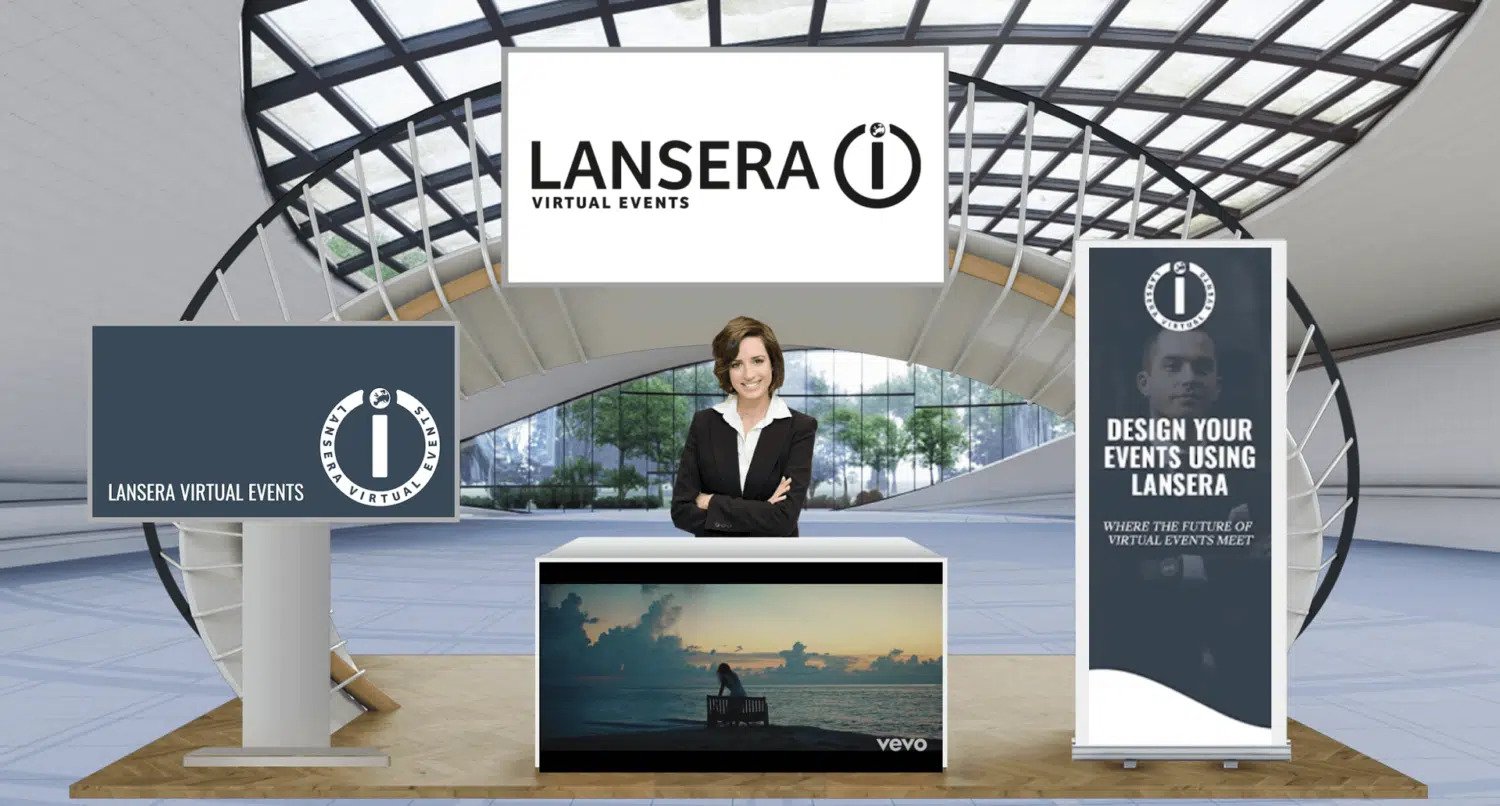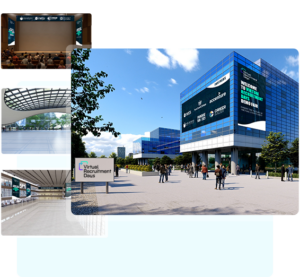Do you wish to leave a lasting impression on your attendees? Create a personalized virtual experience for a target market to engage and interact with your brand. When hosting a virtual event, remember that your audience looks forward to interacting and investing in your brand. So why not give them something memorable to talk about. Unlike physical events, virtual events demand careful effort toward showcasing your brand identity and company culture. But how would you transform the virtual event into a branded environment for the next conference or exhibition?
A virtual events platform allows organizations to customize the virtual environment with company-specific details. In fact, the entire virtual space is custom-designed, from reception, exhibitor halls, booths, and moving avatars to meeting rooms. The visually rich designs, 3D animations, and graphics replicate a real-life office space. As a result, the interactive experience is the same as that of a physical event. Thus, it is important to focus on providing a beyond-reality experience to your attendees who took the time to sign in to the virtual event.
At Virtual Days, we understand how challenging it is to create an exciting and interactive environment for your online attendees. Therefore, we bring to you a comprehensive guide to effective virtual branding for your next virtual event, webinar or conference. But first, let’s talk about what a branded event is.
What is Virtual Event Branding?
Virtual event branding is the process of presenting a personal and impactful image of your company. Here, a company showcases its brand identity to offer an immersive experience to its attendees. Generally, a branded environment displays the brand’s company culture, image, and personality. Overall, it provides a company-specific experience to the event attendees and attracts global sponsors. An effective virtual event is created when all the components are put together, including the company name, logo, themes, colors, designs, and other marketing materials. Also, you get to convey your brand through informational content, news, advertisements and messaging with the event audiences.
Simply put, event branding helps you stand out from the competition and helps establish an individual identity. Your brand should be the only constant your stakeholders, customers, or employees have when navigating through the branded virtual environment from the reception to the halls.
How do you Design a Branded Virtual Environment?
Interestingly, a virtual events platform has a catalog available for the entire virtual event environment, such as entrances, reception, exhibition halls, branded booths, and webinar halls. The event organizers pick an environment from the options available and customize it as per their company culture. Check out how to create the right environment for your virtual event.
In other instances, a virtual environment is designed from scratch with protocols and material specific to your organization. It is either the informative content such as standees, demo videos, or company portfolio that hooks audiences or the company representative avatars that engage the attendees in the best way possible.
However, there’s a list of basic principles to consider when creating a branded virtual environment.
- Focus on displaying brand identity all over the virtual space
- Keep your content unique and simple for the target audience to comprehend
- Authenticity of materials shared is important for your brand name
- Follow best practices specific to your business
- Be honest about your products and services
- Convey branding messages to the target audience
- Earn audience trust with brand-specific content
- Use company representative avatars for the audience to interact better
So, the process of creating a branded virtual event is quite simple when partnered with the virtual platform. To begin with, we have devised a list of virtual environment elements that qualifies for virtual event branding.
Custom Design the Landing Page
Your attendees have the first interaction with your virtual event at the event landing page. It is the platform to receive registrations and guide prospective attendees on the event type, purpose, and outcomes. For instance, a branded demo video at the entrance offers an insight into what awaits attendees. Most importantly, the landing page replicates your physical office location. For example, animations and graphics are used to display the entrance to the corporate building. As a result, attendees experience the virtual environment as if they are actually visiting the physical location.
The event organizers and hosts custom design the landing page using the company name, logos, colors, themes, displays, and company-specific materials. Moreover, the embedded video at the entrance has all the relevant information on the company culture and brand. Actually, the landing page is your first chance to market the brand and attract the target audience to your virtual conference, trade show, or exhibition.
So, make sure your landing page includes the company specified:
- Content
- Offers
- Proposals
- Newsletter
- Updates
- Vision
Showcase Brand Identity at Exhibit Booths
Virtual events allow you to create a personalized booth experience for the attendees. The entire booth is customizable with company-specific materials such as:
- Images
- Standees
- Videos
- Banners
- Company representative avatars.
The moving avatars welcome attendees at the booth and engage them in a live one-on-one chat to educate them on the event, guide them through the segments and redirect them towards meeting rooms. Here, the entire exhibit booth is custom-designed to offer an immersive experience to booth visitors.
In other instances, a trade show event helps multiple exhibitors to showcase their brand identity at the exhibit booths. Thus, each booth displays a different brand and presents unique products and services specific to their business. For example, a virtual expo gathers multiple exhibitors within the exhibition hall and allows attendees to shop for different brands under one roof. But, we can tell each booth apart by the display of its brand identity. Thus, the attendees easily navigate through the exhibition halls and engage with the brands of their interest.
Enhance Virtual Experience through Virtual Venues
A virtual venue is the center of attention for your event. Online attendees move about the virtual space learning about your company, business, services and partners. Therefore, it is best to enhance the virtual experience for your attendees by using company themes, color pallets, and imagery, when crafting true replication of the physical environment. At virtual platforms, the 3D animators and designers create a replica of the physical venue to offer a personalized virtual experience to your attendees as if they were actually present at the location.
Although, it is important to consider that the virtual venue is easy to navigate and offers the right amount of information about your brand. Fortunately, a virtual platform supports customization and personalization of virtual venues to provide an enhanced experience. As a result, the branded environment helps with brand awareness and marketing worldwide.
All in all, a virtual venue encompasses:
- Entrance
- Reception
- Lobbies
- Exhibit booths
- Floors
- Exhibition halls
- Meeting rooms
- Conference rooms
- Webinar halls
Design Branded Webinars and Speaker Sessions
Webinar speaker sessions are the backbone of your virtual events. Most of the attendees busy themselves with the live webinars. Here is a golden chance for your company to display your brand and give detailed presentations on your products and services. For that matter, virtual platforms offer branded webinar templates that are specific to your company. Thus, businesses create a personalized webinar agenda and engage audiences in branded visual and auditory content. Also, sometimes the content is specific to a particular speaker session.
The display of the products and services at the webinar speaker sessions helps promote your brand and earn the interest of potential leads. Moreover, the speaker sessions have built-in call-to-action buttons that direct attendees to make quick purchases right on the platform.
Create Steller Marketing Campaigns
Once a virtual environment is fully customized with the brand identity, use the branded imagery, videos and content for marketing campaigns. For example, some businesses run pre-event marketing campaigns on all their social media channels. Also, email marketing works best when targeted at potential attendees.
But, it is essential to personalize your brand identity, logo, themes, and colors to offer a wholesome experience to your clients. In fact, this helps build their trust in your brand to make informed decisions regarding their purchases.
Most businesses now use social media platforms to run marketing ads and routine posts to keep the target audience informed and interested. Some of the prominent social media platforms used are:
- Facebook ads
- Instagram posts
- LinkedIn ads
- Websites pop-up ads
- Company blogs
- Twitter ads
- Company newsletters
The more people know about your branded virtual environment, the more attendee you have won for the event. Also, make sure the posts are shareable for interested individuals to spread the word about their interests in your brand. At the end of the day, marketing campaigns step up the game for your branded virtual event.
Impress Attendees with Giveaways and Gift Cards
Another chance to make your brand stand out among other exhibitors is by offering incentives and gifts. This is the best way to hook attendees to your exhibit booth. For instance, exhibitors gamily their virtual event to attract a large number of attendees to their booth. So a few get to win gift cards or giveaways. But the more the booth visitors, the more the chances of sales.
Nonetheless, the strategy is effective when you brand your giveaways and gifts. You can custom design the gift cards, coupons or swag bags with company logos, names and colors. As a result, your branded swag has a chance for your company name to circulate around the world.






